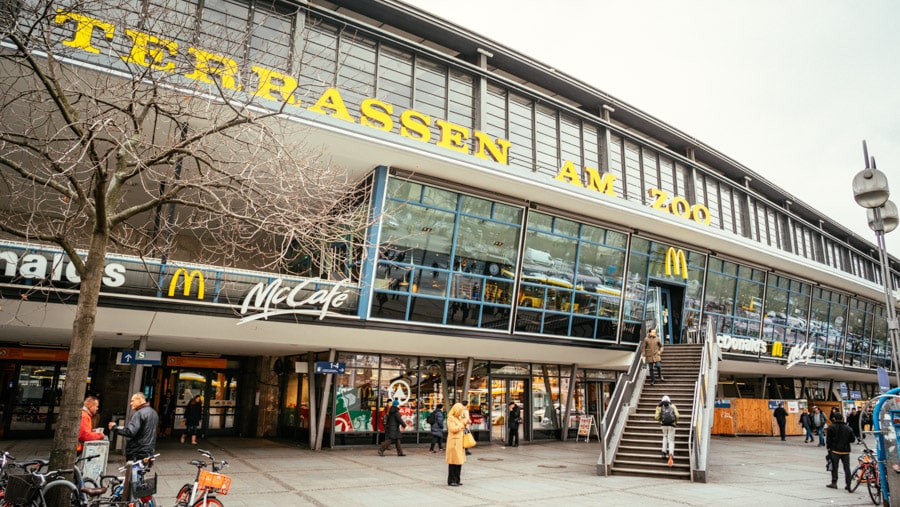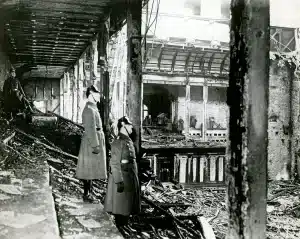Each year more than 17 million of these moveable feasts are sold throughout Germany – in Berlin alone there are over 1,000 eateries dishing out Döners to the city’s 3.7 million residents, and the millions more visiting tourists.
Officially, the Döner Kebab even outsells what is often considered the city’s most famous snack, the Currywurst. Making this hefty shaved elephant leg sandwich Berlin’s fast food snack of choice and an undeniable staple of the German diet.
In-fact, the record for the largest Döner Kebab in the world was set in Berlin, back in 2017 – weighing in at a heartbreaking 423kg.
Despite – or perhaps because of – its obvious popularity, the origin of the humble Döner has been much disputed.
Was it really born out of the demand in 1970s West Berlin for a cheap portable eat, as is often speculated; or does its date back even further into the distant past of Ottoman Turkey?
–
The Gastarbeiter legend & the Doner Kebab

When Turkish-German immigrant Kadir Nurman died in 2013, news outlets worldwide published obituaries for the man it would appear had single handedly transformed street food culture in Germany.
But to ask most Berliners – the name would seem entirely unfamiliar. Not so, say, for Herta Heuwer – the woman credited as having invented the Currywurst in Berlin back in 1949. Many older Berliners at least – both West and East – would be well acquainted with her name.
So what of the King of Kebab?
It turns out Herr Nurmann is not the only person to have claimed to have invented the Döner Kebab. Not even the only Turkish-German immigrant to have done so. Nor the only one in Berlin, for that matter.
In the 1960s, thousands of Turkish guest workers (Gastarbeiter) made their way to West Germany to work, following the waves of Italian, Spanish, and Greek workers who had preceded them. The economic boom period of the 1950s, the so-called Wirtschaftswunder, had led to labour shortages – made more acute by the dramatic reduction of East German workers in 1961 (following the construction of the Berlin Wall).

Despite this shortage, the West German government, in particular Minister of Labour and Social Affairs Theodor Blank, was initially highly reluctant to take workers from Turkey; objecting that the culture gap was too large. It would take intervention from the United States, eager to further align Turkey with the West during the Cold War era, to convince the West German government to sign a bilateral agreement on October 30th 1961.
Soon Turkish citizens would become the largest group of guest workers in West Germany. Although as the country’s economic fortunes changed in the early 1960s, a large number of these were left seeking alternative forms of employment, leading many into that age-old immigrant honey pot – hospitality.
In the process, gifting the country one of its most recognisable icons of cultural integration – the Döner.
Three of these Turkish workers would have their names intrinsically linked with the introduction of the Döner Kebab. The first being Kadir Nurman – recognised in 2011 by the Association of Turkish Döner Manufacturers with a lifetime achievement award and the man most often credited with inventing the Döner Kebab in Berlin.
Nurman arrived in Germany in 1960, first in Stuttgart, before moving to West Berlin aged 32 in 1966. Six years later he established a small eatery (Imbiss) at the Zoologischer Garten train station – correctly anticipating that the working class people in the area would be interested in buying a kebab-to-go. At the time the widespread perception of Kebab was that of grilled skewered meat, served on a plate with rice. What Nurman claims to have offered that was different, was serving it in a form that customers could carry away with them.

Nurman’s Imbiss is no longer there, nor did he patent his creation – a process that would be rather problematic in Germany anyway (where patenting food and recipes is not as easy as simply trademarking a name). But the legend of his resourcefulness and imagination lives on; with it the questions of the accuracy of the claim.
Two other Turkish immigrants have similarly thrown their hats in the ring regarding this creation story. One, Mehmet Aygün, now owns eight restaurants (Hasir) across the city – as well as the well-known Titanic hotel chain in Turkey and Germany. Rumour has it Aygün started working at his parents Turkish restaurant at the age of 16, where he claims to have introduced the Döner Kebab in its current popular form in March 1971. Although elsewhere in press accounts, Aygün is reported to have started working in the restaurant only later in 1974 to support his studies – meaning that his claim as purveyor of the first Döner is brought greatly into question.

The third possible pretender to the throne – Nevzat Salim (also a Turkish Gastarbeiter) – opened a snack stand in the south-west German city of Reutlingen – near Stuttgart – back in 1969. Where he claims he introduced the Döner Kebab, while working alongside his son. If true, that would predate Nurman at Zoo Station by three years. Could it be more than coincidence that both Nurmann and Salim settled in the south west german state of Baden Wurttemberg when they first arrived in the country (with Nurman choosing to move to Berlin)?
As with any culinary creation, sourcing its actual origin is always problematic – like most things, food and recipes evolve. Rather than appear in a poof of meat flavoured smoke. Pinpointing the origin of any recipe is extremely problematic considering the distribution of similar dishes throughout the world, the evolution of techniques over time, and the melting pot movement of migrants that have cross-pollinated cuisine.
–
What Is In A Name?

It should be painfully obvious to anyone who has eaten their way through the culinary landscape that the concept of the Kebab itself did not originate in Berlin.
From the Greek form of Gyros, to the Middle Eastern Shawarma, and tacos al pastor in Mexico, there are, of course, many different variations on the theme that could also be classified as falling into the rough category of ‘Kebab’. All cooked on a vertical rotisserie and served in sandwich form. All with their own equally problematic questions of inception.
Although the provenance of the Berlin Döner Kebab may be in question; its acceptable form is not. And perhaps this is where we are getting somewhere – the difference is preparation and presentation.
This culinary concoction importantly balances four essential ingredients – meat, sauce, vegetables, and perhaps most significantly…oil. The Berlin Döner Kebab should consist of thinly sliced meat (veal or beef) cut from a vertical rotating grill, served in a lightly toasted triangular-shaped bread alongside diced lettuce; cabbage; onion; chopped tomato; and cucumber – with a selection of sauces (garlic, chilli, and herb). Variations exist throughout the city, where the dish is served in a pita bread (like a greek gyros), or wrapped in a lavash or yufka flatbread (called a Dürüm Döner in this form).
Rather than struggle with the Döner Kebab as a magical gift at the masterful hands of a god-like inventor perhaps it better to consider how it may have evolved into its final form.
A little culinary detective work, please…

Arguably the first and most ancient form of this preparation would be that of the şiş (Shish). Said to originate in Turkey (or possibly Persia?), where soldiers would use their swords to skewer and roast meat over an open fire. It doesn’t take much speculation to assume this, however, was not the first time someone impaled something and cooked it over a fire – hundreds of thousands of years of human history stands in the way of that claim. But it is a good starting point here.
Next comes the Cağ kebabı, a stick of spiced lamb, including tail fat, traced back to the 18th century in the Eastern Turkish province of Erzurum – the distant ancestor of the Döner Kebab, as we now know it – cooked horizontally on an open fire.
Later in the 19th century, in either Kastamonu or Bursa, this would be transformed into the rotating vertical meatsicle. Documented in the earliest known photo a vertical kebab taken in 1855 by the British photographer James Robertson – famous for documenting the Fall of Sevastopol in the Crimean war, the same year.

It wasn’t until the 1940s that the rotating vertical Kebab finally made its way to Istanbul, with Beyti Güler (owner of the Beyti restaurant) credited as making the Kebab a mainstream success there – serving heads of state, high-ranking politicians, and celebrities from around the world. Beyti even boasts of having catered for U.S. President Richard Nixon aboard Air Force One during his first official trip to Europe. Although, Beyti Güler is renowned for introducing a different kind of Kebab than the Döner, that now bears his name – the Beyti Kebab. Like most kebabs in Turkey, served in a Dürüm wrap, but made of lamb fillet wrapped in cutlet fat and served on a plate, chopped, and covered in sauce.
It is important to consider that until the 1970s, the Kebab – in any real form it is now recognised – was far from embraced in western Europe. It could easily be argued that it took the influx of Turkish guest workers to Germany to alter the perception of what was commonly viewed as an alien dish.
The greatest achievement of men like Kadir Nurman, Nevzat Salim, and certainly in the present day Mahmut Aygun (who still owns a kebab shop empire), may more specifically be described as having popularised, rather than invented, something that was already around – in various different forms.
Perhaps the easier question to ask is not whether the Döner Kebab was invented in Berlin – but whether it was popularised here?

There is no doubt that Turkey has a strong claim on the Kebab as a general preparation. But the Döner Kebab as a phenomenon may very well belong to Berlin.
Despite the official recognition of Kadir Nurman as the originator of the Döner Kebab, it certainly is possible that when in 1969, in the small town of Reutlingen, fellow Turkish guest worker Nevzat Salim started slinging kebabs that he got there first. But the audience and the reach would certainly have been much smaller.
That Kadir Nurman opened his snack stall at West Berlin’s busiest station, he would undoubtedly have drawn more attention – and although not having invented the Kebab, per se, managed to popularise the Döner Kebab (in its sandwich form).
Acknowledging this, Kadir is quoted as saying: “Maybe someone else also did it, in some hidden corner, but no one noticed. The kebab became well-known through me.”
Kadir’s case for inventor of the modern Berlin Döner becomes even more tenuous when we consider that back in 1972 he admits his version consisted of bread, meat, and a little greenery. And not the commonly accepted form of the Berlin Döner seen today – suggesting it evolved even further from whatever appeared at that time.
One final point is worth considering: the claim that either Kadir, or Nevzat Salim, or perhaps even Mehmet Aygün, may have been the first to put the traditional Turkish Kebab in bread – and serve it to customers.
Has it ever been claimed that the Earl of Sandwich, who since the 18th century has leant his name to anything stuck between bread, could have been responsible for inventing that?
**
Verdict
NO
The Döner Kebab was not invented in Berlin.
Popularised here? Ok.
But there are no participation trophies for that.
***
Our Related Tours
To learn more about the history of East German and life behind the Iron Curtain, have a look at our Republic Of Fear tours.
Think you already know enough about life in the ‘Workers and Peasants State’? Take our Republic Of Quiz and find out.












